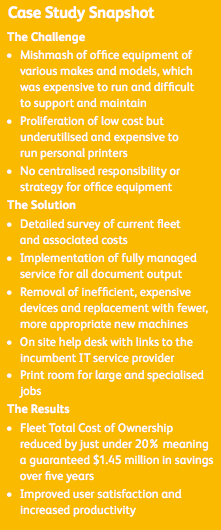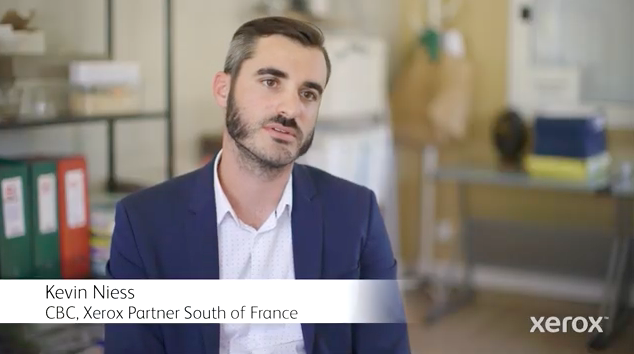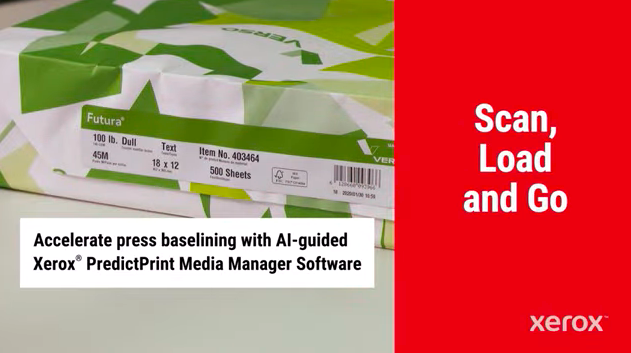Background
Reuters provides vital information to around 370,000 professionals in the financial services arena, and the media and corporate markets. It is also, with 2,400 editorial staff, journalists and photographers in 196 bureaux, the world’s largest international multimedia news agency.
 The enterprise, which can trace its roots back to 1851, now maintains and updates more than 200 million data records containing over 3,000 billion discrete data points. Its annual revenue of approximately £2.6 billion is supported by around 16,900 staff in 94 countries.
The enterprise, which can trace its roots back to 1851, now maintains and updates more than 200 million data records containing over 3,000 billion discrete data points. Its annual revenue of approximately £2.6 billion is supported by around 16,900 staff in 94 countries.
The Challenge
In common with other large, well-established enterprises, Reuters had gradually accumulated a large, mixed fleet of printers, multifunction devices, copiers and faxes. Most of these had been acquired by departments and individual workgroups as and when a need arose, without following any clearly defined strategy.
Even without documented figures, IT Sourcing Manager Nigel Smith knew that this was an area ripe for overhaul.
“We had accumulated a whole mismatch of equipment – different makes, different models; some of it owned, some of it leased and all of it spread throughout multiple offices at multiple sites. We didn’t have and probably couldn’t have a properly effective central support strategy in place. Machines could take a long time to repair.” Although pressing concerns, support and maintenance were by no means the only issues. A steady fall in the cost of printer hardware – especially inkjets – had led to them becoming commodity items within reach of even the most modest office budgets. This resulted in a proliferation of low cost and, in many cases, under-utilised devices with relatively high page costs.
As Reuters began planning the consolidation of 12 of its London offices into four key centres including a new Head Office at Canary Wharf, Nigel seized on the opportunity to introduce a new Print Management Strategy. Conscious of the scale of the challenge, he turned to Xerox for help.
The Solution
To establish the extent of the problem and to identify and quantify the potential savings and efficiency gains, a team from Xerox worked with Reuters to survey the workforce, the equipment and how it was being used. The results were stark.
Xerox discovered that Reuters had accumulated a fleet of 1,046 printers, copiers and multifunction devices, comprised of 242 different models from 27 suppliers. The research also revealed that the company was producing 16.5 million “impressions” per year, equating to around 420 pages per head, per month.
“The numbers were actually lower than I expected – better than the industry average for organisations of a similar size,” said Nigel. “But, still, it was clear that we were looking at an opportunity to make significant changes for the better.”
Xerox introduced a fully managed service that took complete responsibility for the entire document output environment. Inefficient, expensive devices were removed and an optimised fleet of appropriately located, best-for-purpose machines – which included existing equipment, where practicable – was created.
An on-site help desk was introduced, with links to the company’s incumbent IT service provider, and an 8-strong team appointed to take care of service provision and the procurement of all consumables, paper and printers. A print room, to take care of large and specialised jobs, was also established.
The days of Reuters staff buying their own printers, replenishing ink and paper, or suffering with faulty equipment are long gone.
“Xerox monitors the fleet continually,” said Nigel. “It’s very rare to come across a printer that’s run out of toner or paper, and if a paper jam happens it’s not uncommon to discover an engineer fixing it even before a support call is made.”
As well as the obvious gains in user satisfaction and productivity, the new managed service has delivered significant and substantial savings. Xerox has helped Reuters to reduce the total cost of ownership by as much as 19.2% per annum, which equates to $1.45 million over the life of the 5-year contract, figures that can be established thanks to accurate and detailed reporting – another benefit of the Xerox service.
The Future
“We’re in good shape. Everything works, availability is at all time high and everything is taken care of for us. What’s more, we have a clear understanding of exactly what we’re spending and saving and where,” said Nigel. “I don’t think there will be any radical changes in the near future. There doesn’t need to be. As individual machines wear out we’ll probably replace them with Xerox® equipment that seems sensible – but it’s good to know that Xerox can support us whatever we decide.”





